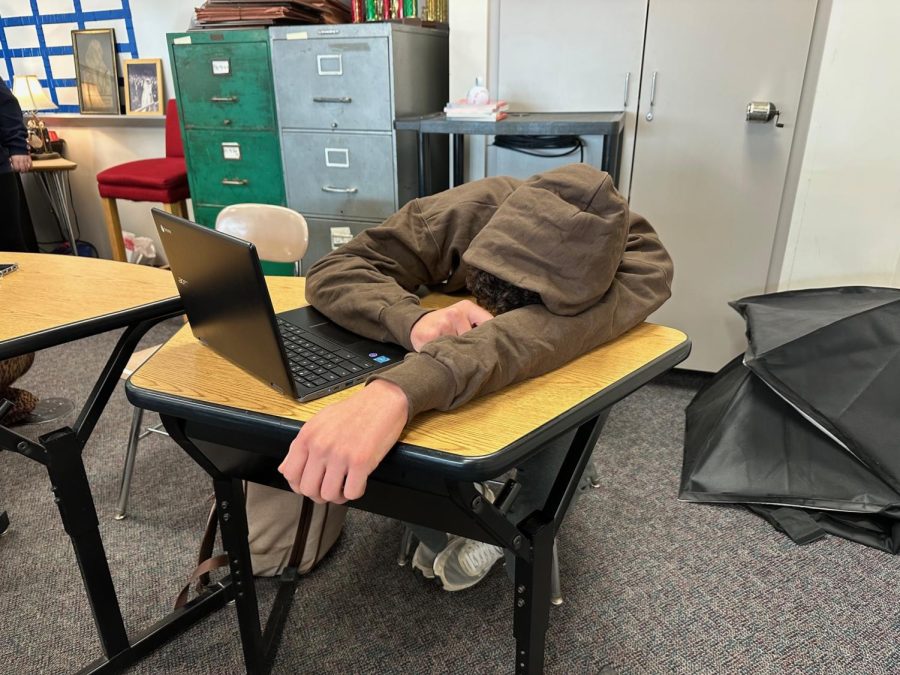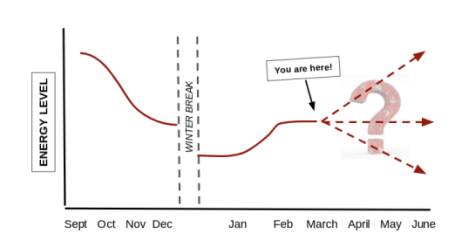Don’t hit snooze, break free from those winter blues
Tired student can’t keep their eyes open in school.
It’s a dark, dreary morning. You’ve already hit the snooze button 4 times, longing for just a few more minutes of sleep. The temperature outside is 15°F, and your bed feels like a cozy safe haven from the world. You contemplate if you should just stay home for the day, but eventually force yourself to get out of bed and get ready for school. Although the sun hasn’t risen yet, your day has started.
The scenario described above depicts a typical school morning for the majority of high schoolers, particularly in the winter. At this time of year, it’s common for students to feel a dip in energy and motivation– alongside the dip in temperature. I sat down with Robert McCreary, a psychology teacher at North Penn, to discuss why this tends to happen.
“I think several things come into play. First, the excitement of the winter holidays has worn off and students realize that the vacation is over and it’s time to get back to work. Second, students know that spring break–the next big vacation– is several months away. Third, seniors are starting to receive their acceptance letters from college, and unfortunately for some, they see this as an opportunity to scale back their effort levels and motivation. In other words, “senioritis” manifests itself at higher levels. Lastly, the cold, dark winter months can dampen motivation as well. Put all that together and this time of year can lead to lower motivation levels in everyone,” McCreary explained.
Along with all of these factors, there are also proven concepts in psychology that back up these enhanced feelings of exhaustion during the winter.
“Seasonal affective disorder is a mental disorder that affects some people at the change of seasons. Symptoms may include increases in irritability, anger, and other negative emotions. In some cases, it can lead to severe depression as well. Psychologists say the decrease in sunlight during the winter months plays a large role in this,” McCreary elaborated.
The graph above illustrates the typical path that most students’ energy levels follow throughout the school year. Observing the red line, energy levels start out high in the beginning of the year, and the new school year brings in new hopes and a new start. However, as months progress, most students lose this once-potent energy and reach an all-time low right after winter break. But as the second semester approaches and a chance for a fresh start becomes available again, energy levels appear to rise.
You are now at crossroads: which path will you take to finish out the rest of your year? Will your energy rise, drop, or plateau? Luckily, there are many actions you can take to ensure you are part of that first option.
“The first is for students to realize that there are, in fact, many things a person can do to improve motivation levels. This will give them an internal locus of control – a belief that you control your life or at the very least, the belief that you can control how you react to events in your life – as opposed to the mindset of being controlled by outside forces like the month, the weather, etc. All the strategies will mean nothing if a student doesn’t think they can do anything to positively affect their life,” McCreary warned.
That being said, here are some additional factors that can contribute to maintaining a higher motivation level.
Sleep: This is the most important factor (after the internal locus of control). Negative consequences start to emerge if a teenager is regularly getting less than 7 hours of sleep and does not have an established sleep schedule. Work on improving your sleep habits to improve your overall quality of life!
Sunlight: Get more light, especially early-morning sunlight. Several positive bodily functions can kick start into action when sunlight enters our eyes after waking up. Missing that light by sleeping too late or staying indoors too much can confuse your body.
Exercise: This one shouldn’t come as too much of a surprise- every gym class repeatedly emphasizes that exercise can improve your mood and increase energy. You just have to make the time!
Water: Drink more water! The winter months tend to be dryer, leading you to get dehydrated faster. Put down those caffeinated drinks and reach for water instead to improve your alertness.
Screen time: Log off! More screen time is shown to go with higher levels of negative emotions, while less screen time seems to go with lower levels.
Seasonal hobby: Find a winter hobby to make this time of year a little less dreadful. Some common hobbies are skiing, snowboarding, baking, volunteering, etc.
While these are plenty of helpful strategies, there is also the Student Assistance Program (SAP) that you can join if you could use a little extra help.

“The Student Assistance Program is a state-wide program for schools with the goal of providing support to students outside the classroom. If a student chooses to become part of SAP, we try to match up a student with support tailored to their needs. In some cases, it could be just a mentor who checks in on them every once in a while. For others, we may connect them to other professionals in and out of the high school in order to address their needs,” McCreary, head of the SAP program, explained.
SAP posters with QR codes are hung up all over the school if you ever want to reach out for some additional support. Although the winter months can be tough, SAP is always here to assist you. Take care of yourself and finish this school year on a high note!



